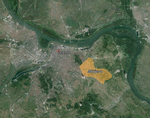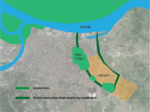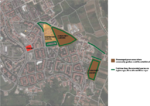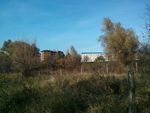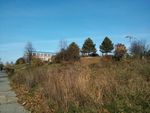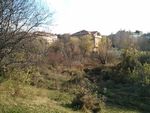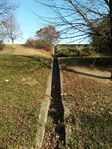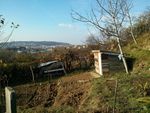Green Infrastructure 2014 Group K - Case Study 2
---> back to group page working group K
please add your title here
| Name | Mirijevo | |
| Country | Serbia | |
| City | Belgrade | |
| Authors | Milena Stefanovic | |

| ||
|
| ||
Rationale: Why is this case interesting?
Serbia [1] is developing country situated at the crossroads between Central and Southeast Europe, covering the southern part of the Pannonian Plain and the central Balkans. Serbia has very favourable natural conditions (land and climate) for varied agricultural production. It produces mostly grains, fruits and vegetables which constitute a significant part of its GDP and exports. There has been in a sharp decline in agricultural activity since 1948, when almost three-quarters of the population engaged in farming, to the present one-quarter.
Mirijevo [2]is an urban neighborhood of Belgrade, the capital of Republic of Serbia. It is part of Belgrade's municipality Zvezdara. Mirijevo is located around 7 km from city center on the eastern outskirts of Belgrade's urban zone. Mirijevo is residental neighborhood with plenty of green spaces and hiking trails. Mirijevo hasn't cycling trails. It has one food market where people can buy domestic and foreign products. Residents of Mirijevo are mostly families with children and older retired people. They enjoy hiking and gardening. Mirijevo has large potential for developing urban agriculture. Benefits would be significant contribution to fruit and vegetable requirements, reduction of energy used to distribute food, biodiversity enhacement and positive social and health impact.
Author's perspective
I graduated landscape architecture and horticulture at Belgrade University. Now I'm working on my PhD Thesis at Institute for Biological Research in Belgrade, on Department for Ecology. For my PhD thesis, I do research on biodiversity of forest ecosystems. I am also interested in research on urban biodiversity.
I chose Mirijevo for my case study, because I have been living there for fourtheen years. When I first moved in 1990, Mirijevo was neighborhood with planty of green areas and rich biodiversity. A wide viriety of plant species, insects and birds are found their habitat in Mirijevo. As time passing by, the human population is incresing and urban tissue is expanding at the expense of green areas. There is a lack of planning in bulding process, so many green corridors are becoming defragmented and many species are loosing their habitat.
Landscape and/or urban context of your case
- Biogeography, cultural features, overall character, history and dynamics
Topography
Terrain in Mirijevo has valley shape, with highest countour of 200 m above see level. Lowest contour is at 100 m above see level, where the Mirijevo stream is situated. West-facing slopes and east-facing slopes are predominant.
Climate
Belgrade is characterized by a moderate continental climate with local varieties. The mean annual air temperature is 11.9 ° C, and at the town periphery and at higher altitudes around 11.0 ° C . January is the coldest month, with average temperature of 0.10 ° C. The hotest month is July with average temperature of 22.1° C. Belgrade has four seasons. Autumn is longer than spring, with longer sunny and warm periods - the so-called Indian summer. Winter is not so severe, with an average of 21 days with temperature below zero. Spring is short and rainy. Summer arrives abruptly. The average annual number of days with temperature higher than 30°C (the so called tropical days ) is 31 .
The characteristic wind directions in Belgrade are southeast and northwest. Southeast wind is known as Košava and it brings clear and dry weather. It mostly blows in autumn and winter, in 2-3 days intervals. The average speed of Košava is 25-43 km/h but certain strokes can reach up to 130 kmh. Košava is the largest air cleaner of Belgrade.
The average annual rainfall on Belgrade and its surroundings is around 670 mm. The rainiest months are May and June. October and August have the smallest amount of rainfall. The average annual insolation is 2.096 hours. The highest insolation of about 10 hours a day is in July and August, while December and January are the most cloudy, with insolation of 2 to 3 hours per day. The average number of snowy days is 27. Snow cover lasts from 30 to 44 days, and its average thickness is 14 to 25 cm. Mean atmospheric pressure in Belgrade is 1001 millibars and mean relative humidity is 69.5%.
Soil
A typical soil in Belgrade is cambisol. Cambisols make good agricultural land. In temperate climates they are among the most productive soils on earth. Cambisols have good physical and chemical properties and they are more suitable for autochthonous species.
Vegetation
The Hungarian oak -Turkey oak forest (Quercetum frainetto-cerris Rud.) is the most common forest type in Serbia. Characteristic associations for Belgrade are: Rusco- aculeati- Quercetum frainetto- cerris, Quercetum frainetto- cerris virgilianae, Quercetum cerris- virgilianae, Salicetum albo- amygdalinae and Salicetum albae- fragilis (Sarić, 1997). However, Mirijevo has wide variety of plant species, autochthonous as well as allohtonous. Landscape architects were very imaginative when they were making plant selection. I made a record of the woody plant species, but this record is not complete (Table 1). Beside woody plants, wide variety of herbaceous plants is growing in Mirijevo.
- Illustrations: maps; sketches; short descriptive analyses
- Illustrations
- Yourimage.jpg
your visual
Analytical drawings
- Please use analytical drawing for visualising the conflicts/potentials of your site
- Analytical Drawings
- Your drawing.jpg
your drawing
- Your drawing.jpg
your drawing
- Your drawing.jpg
your drawing
Green Infrastructure benefits for this site
Look again at the multiple benefits of green infrastructure - what could be achieved in your site and which are most relevant?
Potential for multifunctionality
Green infrastructure has typically multiple functions. What could be achieved for your site in this respect?
Projective drawings
- How would you like this case to change in the near future? (in 1-2 years)
- you may add a short explanation here
- And how could it look like in 10-15 years?
- you may add a short explanation here
- Projective Drawings
- Yourdrawing.jpg
projective drawing
- Yourdrawing.jpg
projective drawing
- Yourdrawing.jpg
projective drawing
Summary and conclusion
- 100 words approx.
Image Gallery
- Image Gallery
References
- please add your references here
About categories: You can add more categories with this tag: "", add your categories
